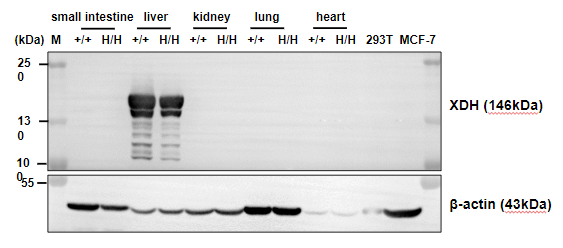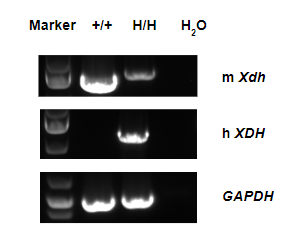Basic Information
-
Targeting strategy

-
Gene targeting strategy.
The exon 1 of mouse Xdh gene was replaced by human XDH CDS as well as human 5’UTR and human 3’UTR region in B-hXDH mice plus. -
Protein expression analysis

-

Strain specific XDH protein expression analysis in homozygous B-hXDH mice plus by western blot. Tissues were collected from wild-type C57BL/6 mice (+/+) and homozygous B-hXDH mice plus (H/H), and analyzed by western blot with a known cross-reactive anti-XDH antibody. The XDH protein can be detected in wild-type C57BL/6 mice and homozygous B-hXDH mice plus.
-
mRNA expression analysis

-

Strain specific analysis of XDH gene expression in wild-type C57BL/6 mice and B-hXDH mice plus by RT-PCR. Mouse Xdh mRNA was detectable in C57BL/6 mice (+/+) as well as homozygous B-hXDH mice plus (H/H). Human XDH mRNA was detectable only in homozygous B-hXDH mice plus (H/H), but not in wild-type mice. The results of sequencing showed that there was mouse Xdh mRNA in homozygous B-hXDH mice plus.
-
Inhibitory efficiency of the nucleic acid drugs against the XDH expression level

-

The inhibitory efficiency of the nucleic acid drugs against human XDH mRNA in liver tissue in B-hXDH mice plus. B-hXDH mice plus were randomly divided into three groups (n=3/group, 8 weeks old). The human XDH targeted nucleic acid drugs (synthesized according to patents) and PBS were administered to the mice individually. The nucleic acid drugs was administered in the form of PBS aqueous solution. G1 group was only treated with PBS aqueous solution. The drug dosages for all animals were calculated according to the body weight. The mice were sacrificed on day 7, and the liver tissue was collected to detect the expression level of human XDH mRNA by qPCR. (A) The schematic diagram of experimental processing. (B) The expression of human XDH mRNA in liver after treatment. The inhibition rate in the treatment group was 83.4%, demonstrating that B-hXDH mice plus provide a powerful preclinical model for in vivo evaluation of human XDH targeted nucleic acid drugs. Values are expressed as mean ± SEM.
-
Summary

-
mRNA expression analysis:
Mouse Xdh mRNA was detectable in C57BL/6 mice (+/+) as well as homozygous B-hXDH mice plus (H/H). Human XDH mRNA was detectable only in homozygous B-hXDH mice plus (H/H), but not in wild-type mice.Protein expression analysis:
The XDH protein can be detected in wild-type C57BL/6 mice and homozygous B-hXDH mice plus.In vivo efficacy:
Human XDH targeted nucleic acid drugs (synthesized according to patents) was efficacious in B-hXDH mice plus.


